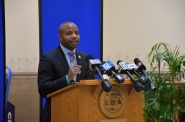Why Al’s Run Was Canceled
It doesn’t raise much money. So why is Children’s Wisconsin hospital seeking some way to continue it?
The recent news that the Briggs & Al’s Run would be canceled was a surprise to many in the community and the explanation, that the number participating in the run had declined and a more “inclusive” event might eventually be created, raised more questions than it answered. The real explanation goes far deeper: it’s a story about massive change for the hospital and the Milwaukee community over the last 30 years.
The first Al’s Run to benefit Children’s Hospital was held 45 years ago, on September 30, 1978. Back then Children’s was a small hospital still located on the city’s Near West Side, with a budget that was probably under $10 million and a president who earned in the neighborhood of $50,000. As recently as the early 1990s average-sized hospitals paid their executives as little as $100,000.
Today the hospital is known as Children’s Wisconsin, and it has a huge facility located at the regional medical center in Wauwatosa. Children’s has expanded four times, with the most recent project, announced in 2020, having an estimated cost of $385 million. The hospital has an annual budget of $728 million (as of its 2019 federal tax form), and its president Peggy Troy’s annual compensation was just under $3.8 million. The hospital has a separate entity, Children’s Wisconsin Foundation, which oversees Al’s Run and has an astounding $1.2 billion in assets, including investments totaling $887 million.
Back when former Marquette basketball coach Al McGuire had the lovely idea of raising money to help treat sick children, hospitals were operated like charitable organizations. The head of St. Mary’s Hospital was a nun who had taken a vow of poverty and was paid $1 a year. The first Al’s Run raised $18,000, news reports show. The next year the run raised $42,800.
In the decades since then, as Children’s transformed into a massive corporate-like entity, Al’s Run also grew, but far more moderately. It hit a peak of 30,000 participants and the net amount earned from it rose to as much as $500,000 or $600,000 per year, according to Andy Brodzeller, External Communication Director for Children’s, in an interview with Urban Milwaukee. Much of that came from sponsors, led by Briggs & Stratton, which became the lead donor, as it was renamed the Briggs & Al’s Run, putting the late MU basketball legend in second place.
But over the years there has been a big increase in various charitable runs and runners can pick and choose their favorite. In 2022, there were just 8,000 participants in the run and the net revenue for Children’s was an anemic $120,000.
Part of that may also reflect less money coming from lead sponsor Briggs & Stratton. In a 2018 story by the Biz Times, the company said it had donated more than $5 million to the hospital over 23 years as a lead sponsor, an average of about $220,000 per year
But in July 2020 the company went bankrupt, just after awarding $5.125 million in bonuses to top executives. KPS Capital Partners, a New York City-based private-equity firm, acquired the company when it was the only bidder after Briggs filed for bankruptcy
The company’s new president and CEO Steve Andrews promised that “Briggs & Stratton has no intentions of exiting Milwaukee,” and would continue to support the Briggs and Al’s Run. But did the company reduce its level of support?
Brodzeller declined to answer this question but said only that moving forward, Children’s “will have conversations with all the major stakeholders, including Briggs & Stratton.”
For the Children’s Wisconsin Foundation, which brought in $94 million in revenue in 2020, including grants, contributions and investment earnings, the $120,000 earned by the 2022 run amounts to a rounding error. Or 3% of its president’s annual compensation in 2019.
Meanwhile, an email from the foundation to supporters noted, “event logistics and regulations have become increasingly complicated and costly.” In short, it’s a lot of work for a tiny return, by an entity sitting on $1 billion in assets.
“When Al’s Run started, it was to support Children’s Hospital,” Brodzeller notes, “but over time it became a way for families to celebrate and commemorate the journey these families have been on.”
These are families who may have seen a child or children go through some sickness or disease and survived, with the help of the hospital, and the annual run becomes a way to celebrate (or memorialize if a child was lost). “We recognize that the event has meaning for many and is an important part of the community,” Brodzeller says.
As for more inclusiveness, while the run has included a 5K wheelchair run, the issues are broader and more about convening thousands of families and children in the downtown area and creating a comfortable, easy-to-access event.
“We have gotten regular feedback over the years about the complexity of the event for families, and the limitations on accessing certain facilities,” Brodzeller notes. And so they are asking for feedback from families through this survey to help determine how to change the event.
“We are committed to holding an event in 2024,” Brodzeller says, and some kind of walk and run “would be part of that.”
But it won’t be about the money. Al’s Run has long since become of little importance to the Children’s Wisconsin budget.
Murphy's Law
-
National Media Discovers Mayor Johnson
 Jul 16th, 2024 by Bruce Murphy
Jul 16th, 2024 by Bruce Murphy
-
Milwaukee Arts Groups in Big Trouble
 Jul 10th, 2024 by Bruce Murphy
Jul 10th, 2024 by Bruce Murphy
-
The Plague of Rising Health Care Costs
 Jul 8th, 2024 by Bruce Murphy
Jul 8th, 2024 by Bruce Murphy






















Perhaps some questions to be asked:
How much charity care was provided by Children’s in 2022?
How much property tax did they pay in 2022?
What is the total amount listed as owed to Children’s in bankruptcy filings in 2022?
And how many or what percentage of bankruptcy filings in 2022 included an amount owed to Children’s?
Peace, TW